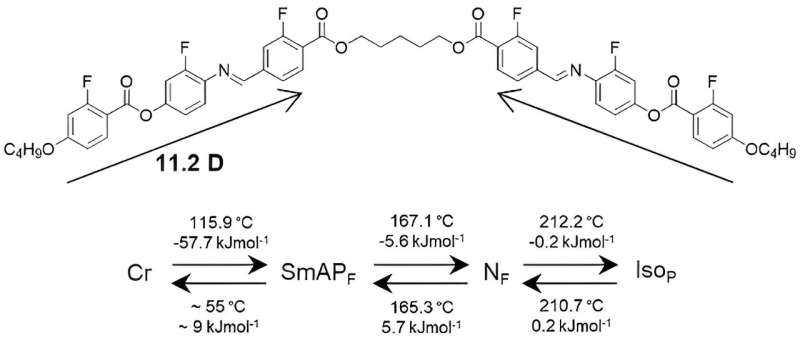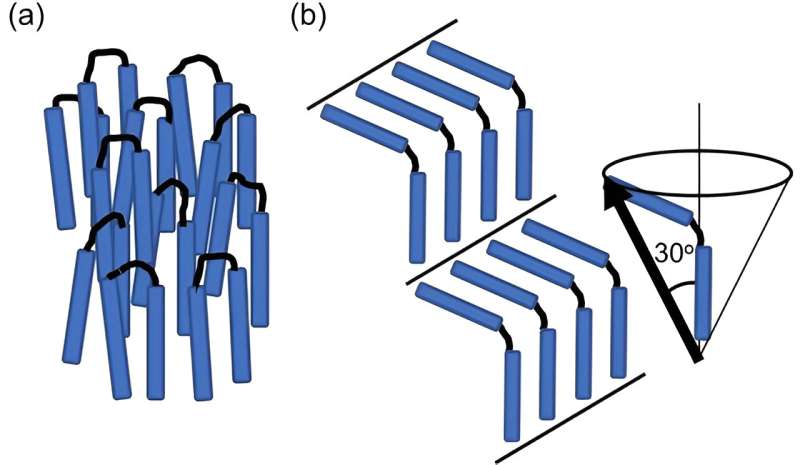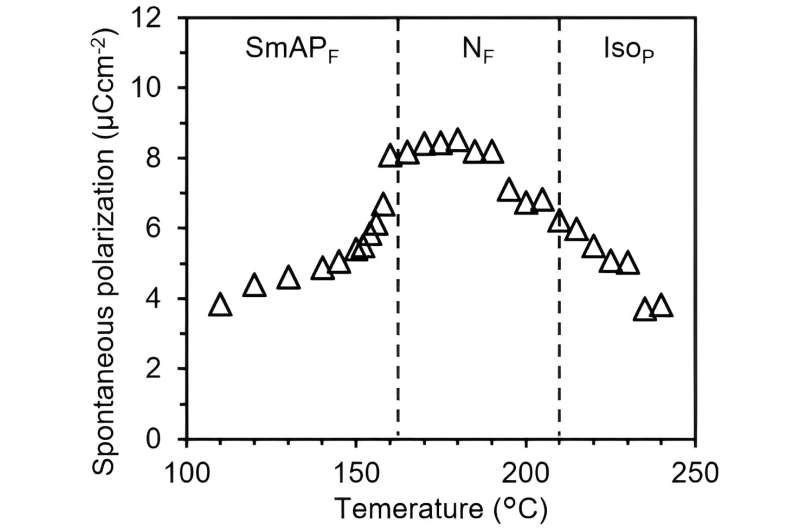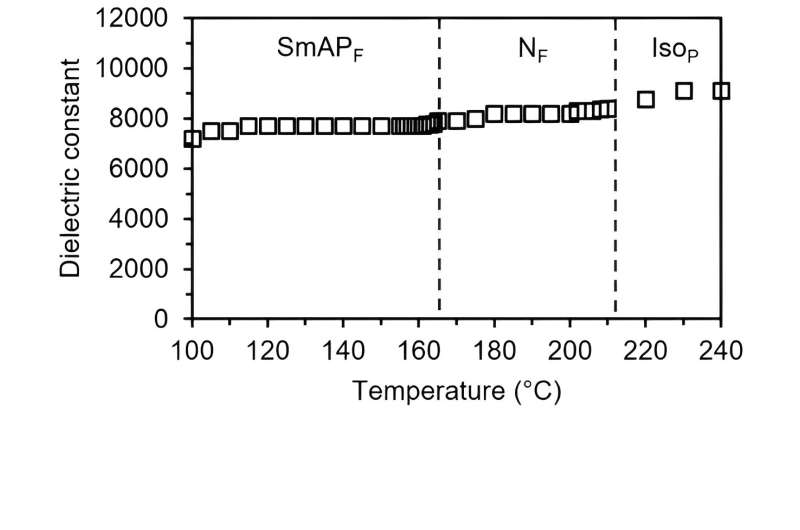This article has been reviewed according to Science X's editorial process and policies. Editors have highlighted the following attributes while ensuring the content's credibility:
fact-checked
peer-reviewed publication
trusted source
proofread
A ferroelectric dimeric liquid crystal with huge spontaneous polarization and dielectric constant at low temperatures

At the Tokyo Tech LG Material & Life Solution Collaborative Research Cluster, a joint research team has developed a ferroelectric dimeric liquid crystal with spontaneous polarization that exceeds (8 μCcm-2) and a dielectric constant that exceeds 8,000 at low temperatures. The findings are published in The Journal of Physical Chemistry B.
Ferroelectric liquid crystals are a unique type of liquid crystal that have high spontaneous polarization and dielectric constant. Among these, dimeric molecules have a simple molecular structure and can form a ferroelectric phase at low temperatures, so they are expected to be a material with many applications.
The joint researchers developed a dimeric molecule called di-5 (3FM-C4T), which has a fluorine-substituted mesogen core linked to side wings by a pentamethylene spacer.
Researchers confirmed that this dimeric molecule exhibits liquid crystallinity at low temperatures (55°C to 211°C), and is composed of three polar phases: nematic, smectic, and isotropic, with a huge spontaneous polarization (8 μCcm-2) and dielectric constant (8,000).
The researchers succeeded in developing a dimeric liquid crystal that exhibits ferroelectricity at low temperatures. Using the dimeric molecules developed through this research will enable the creation of technology such as capacitors for smaller electronic devices and lower power consumption, piezoelectric elements and electrostatic actuators that can be driven at low voltages, and holographic displays that show three-dimensional videos.
This development is expected to lead to new applications in fields such as automobiles, industrial robots, and medical equipment.
These research results were achieved by the Tokyo Tech LG Material & Life Solution Collaborative Research Cluster, composed of Shigemasa Nakasugi (Joint Researcher with Industry and Other Organizations Including the Private Sector), Adj. Prof. Hiroki Ishizaki, Adj. Assoc. Prof. Sung Min Kang of LG Japan Lab, Prof. Masato Sone, Adj. Prof. Junji Watanabe and Assoc. Prof. Tso-Fu Mark Chang of the Laboratory for Future Interdisciplinary Research of Science and Technology, and Professor Takaaki Manaka of the School of Engineering, which is a joint research organization of LG Japan Lab and Tokyo Institute of Technology.
The results were published in the Journal of Physical Chemistry B.

Ferroelectric liquid crystals are expected to have innovative applications in electronic devices because they exhibit higher spontaneous polarization and dielectric constant than conventional liquid crystals. Furthermore, because of their high-speed switching properties and memory effect, they have recently attracted attention as a favorable material for realizing holographic displays that require fine pixel structures.
The ferroelectricity requires a reduction of molecular symmetry and the chiral smectic-C phases with chiral molecules, the nematic phases with the specific functional groups, and the bent-shaped molecules with a bent structure have been developed so far.
In particular, the bent-shaped molecules have the property that the bent structure of the molecule lowers the intramolecular symmetry, and the ferroelectricity can be expressed with a simple molecular structure that does not require the introduction of specific functional groups.
In addition, some bent-shaped molecules are known as dimeric molecules. While most bent-shaped molecules have mesogen linked to the 1,3 positions of the aromatic core, the dimeric molecules contain a flexible alkylene group (odd-carbon number) as the mesogen linkage.
This flexible alkylene group enables the dimeric molecule to form the ferroelectric phases at lower temperatures than conventional bent-shaped molecules, which is superior in terms of application development.
In this study, the research team focused on the dimeric molecules to develop new materials with huge spontaneous polarization and dielectric constant.

The researchers developed a novel dimeric molecule with a large dipole moment to achieve huge spontaneous polarization and dielectric constant. Specifically, they synthesized a dimeric molecule, di-5 (3FM-C4T), which has a fluorine-substituted mesogen core linked by pentamethylene spacers as side wings.
Due to effective fluorine substitution, the mesogen core of di-5 (3FM-C4T) was found to have a very large dipole moment of 11.2 D by density functional theory. Di-5 (3FM-C4T) was structurally analyzed to reveal a ferroelectric nematic (NF), ferroelectric smectic-A (SmAPF), and polar isotropic (IsoP) phases.
The NF phase consists of U-shaped molecules and has huge spontaneous polarization of about 8 μCcm-2, reflecting the large dipole moment of the mesogen core. On the other hand, the SmAPF phase consists of molecules with a bent shape and has high spontaneous polarization of about 4 μCcm-2.
The spontaneous polarization of SmAPF phase is half that of the NF phase, which is due to the halved dipole moment in the bent molecule with a bent angle of 120° in a comparison of the U-shaped molecules. The IsoP phase on the high-temperature side, which is still under structural analysis, still shows a polar structure and may have polar aggregation of molecules in small domains.
These polar phases exhibit a dielectric constant of more than 8,000, reflecting large dipole moments.

By applying the newly developed bent-shaped dimeric molecules with huge spontaneous polarization and dielectric constant as a medium, it is possible to realize a variety of high-performance electronic devices. For example, the application to the capacitors will enable miniaturization and low power consumption of electronic devices.
Furthermore, the application to the piezoelectric elements and electrostatic actuators will enable low-voltage drive, contributing to improved control technology and energy-saving industrial processes.
In the application to 3D video display elements, the technology is promising as an enabling technology for holographic displays because it is less likely to cause crosstalk between pixels in a fine pixel structure and enables high-speed optical switching. Thus, new applications are expected in fields such as automobiles, industrial robots, medical equipment, and video display devices.
In this research, the three polar phases of the developed bent-shaped dimeric molecules are viscous liquids, and research on immobilization techniques such as elastomerization and gelation is essential for practical applications.
With the development of immobilization techniques, the application fields of ferroelectric materials are expected to expand and develop into new application fields.
More information: Shigemasa Nakasugi et al, Three Distinct Polar Phases, Isotropic, Nematic, and Smectic-A Phases, Formed from a Fluoro-Substituted Dimeric Molecule with Large Dipole Moment, The Journal of Physical Chemistry B (2023). DOI: 10.1021/acs.jpcb.3c02259
Journal information: Journal of Physical Chemistry B
Provided by Tokyo Institute of Technology





















